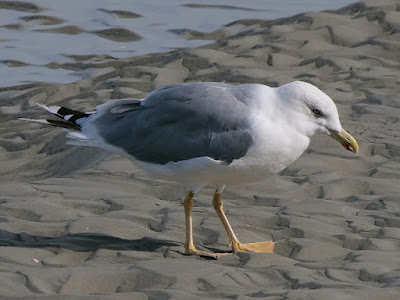Megan and I spent a week in a mobile home on a campsite at Drancourt, just outside St. Valery-sur-Somme. Tis visit, our 7th, had been scheduled for 2020 but was delayed by Covid-19. We crossed from Newhaven to Dieppe from where our destination was an hour's drive to the north. As well as daily walks in and around Drancourt we visited St. Valery, Le Hourdel, Le Treport, Cayeux-sur-Mer (by old train), Marquenterre and Abbeville (Hyper U). We'd taken the DVD of a French TV crime series Witnesses (Les Témoins) set in the area and enjoyed watching it and recognising a few of the locations.
It was nice to be away with Megan but birds were less evident than on previous visits which was disappointing, more so as Sussex seemed to do quite well while we were away. Autumn migrants were very thin on the ground with single Pied Flycatcher, Common and Black Redstarts and Whinchat and just 3 each of Spotted Flycatcher and Wheatear.
I saw Crested Tit twice in the pines at Drancourt (and another 2 at Marquenterre), a below average showing but still most welcome. The same couldn't be said of Short-toed Treecreeper which I'd seen on all previous visits but not this time. My deteriorating hearing might have been a factor although I did see 2 Firecrests, one of which I first heard. Red Squirrels were seen at Drancourt most days.
A male Hen Harrier was seen hunting over the fields behind Drancourt twice and a ring-tail three times, but they were always at some distance. A welcome return after two blank visits. Despite looking daily it was the first time I failed to find any Grey Partridges although most of the nearer fields were quite bare. A Hare was some compensation.
Some species were doing very well with Spoonbills regularly seen on the estuary and about 200 roosting at Marquenterre. Cattle and Great Egrets were seen most days with maximum daily counts of 41 and 5 respectively. I saw 5 White Storks, my highest total at this time of year although they have been breeding in increasing numbers at Marquenterre since 2000. Might they have made it across the channel and established themselves breeding in Sussex? We'll never know with the introduction of Polish birds at Knepp.
Our visit to Marquenterre was disappointing despite it being over a high tide with 10 Ruff, a Spotted Redshank and 10 Greenshank the most notable waders seen. It is very popular with visitors but isn't set up for birders. The reserve opens at 10am, most pools are only viewable from hides which never seem to be ideally located, have limited viewing slots at various heights (many suitable only for midgets or giants) and have virtually no seating. A dog sized Wild Boar piglet seen in the woods by the car park was probably the highlight of our visit to Marquenterre.
Both ferry crossings produced about 100 Gannets with single Great and Arctic Skuas on the return.
 |
| Gannet from the ferry |
 |
| adult Yellow-legged Gull at St Valery |
 |
| easy to identify at this age |
 |
| Crested Tit at Drancourt, always a favourite |
 |
| Spoonbill at St Valery |
 |
| Spoonbills on the mudflats at St Valery |
 |
| Le Treport's very efficient Funicular |
 |
| beach huts at Cayeux-sur-Mer |
 |
| Megan on the Bay of the Somme Railway at Cayeux-sur-Mer |
 |
| ageing gracefully |
 |
| Spoonbill at St Valery |
 |
| Spoonbills at St Valery |
 |
| Great Egret at Marquenterre, one of the few birds right in front of a hide |
 |
| Spoonbills from the closest hide at Marquenterre |
 |
| Cattle Egrets and Henson Horses at Marquenterre |
 |
| Wild Boar piglet at Marquenterre |
 |
| it seemed completely unconcerned to be on its own |
 |
| Megan at Drancourt |
 |
| the campsite is immediately behind the central block of trees and we made it back just before the rain |
 |
| Cattle Egrets near Drancourt |
 |
| Green Sandpiper near Drancourt |
 |
| Grey Wagtail near Drancourt |
 |
| young Gannet from the ferry |
 |
| first sight of the Sussex coast - Seaford to Beachy Head and Eastbourne |





























No comments:
Post a Comment
Note: only a member of this blog may post a comment.